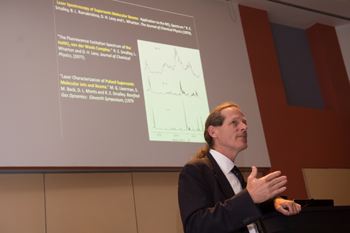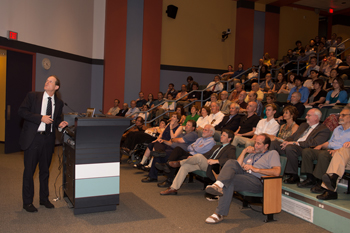CalTech scientist on buckyball discovery team visits to celebrate science legacy

Rice graduate Jim Heath returned to help celebrate the birthdays of his mentors, Richard Smalley and Robert Curl, on June 6. Photo by Jeff Fitlow
Jim Heath ’88 still feels the heat of Rick Smalley’s “steely blue eyes” looking over his shoulder.
A packed McMurtry Auditorium heard Heath talk about his mentors at Rice as well as his research in the fight against cancer at the Smalley-Curl Celebration on the past, present and future of nanotechnology June 6.
Heath, the Elizabeth W. Gilloon Professor of Chemistry at the California Institute of Technology, was a graduate student of the late Smalley and a member of the team that discovered the carbon-60 fullerene, aka the buckyball, in 1986. Smalley won the 1996 Nobel Prize in Chemistry for the discovery along with Robert Curl, University Professor Emeritus and the Kenneth S. Pitzer-Schlumberger Professor Emeritus of Natural Sciences, and Harry Kroto, the Francis Eppes Professor in the Department of Chemistry and Biochemistry at Florida State University.
The event sponsored by the Smalley Institute for Nanoscale Science and Technology and the Rice Quantum Institute celebrated the 70th anniversary of Smalley’s birth and Curl’s approaching 80th birthday.
When Heath came to Rice to work in Smalley’s lab, he said, Smalley and Curl “weren’t founders of the Rice Quantum Institute; they weren’t the founders of anything. They were teachers. They were great teachers, and that’s what the university is all about.” He described Smalley’s intensity and Curl’s thoughtfulness as key to their working relationship.

Jim Heath, now a professor at CalTech, told the audience at Duncan Hall's McMurtry Auditorium he still feels inspired by what Bob Curl and the late Rick Smalley taught him during his time at Rice. Photo by Jeff Fitlow
“Rick was always really aggressive. He had these steely blue eyes, and he would look at you and just fix you with these, and there was no escape. He would drain every bit of knowledge out of you.
“He had this intensity, just like a bull … and Bob, on the other hand, would think deeply about things,” Heath said. “Rick told me (he) stayed at Rice mostly because of Bob. Our interpretation as students was that if Bob agreed with you, you were right. And without Bob, Rick would have gotten in a lot of trouble.”
Heath said Smalley was a constant presence in the lab, even though “he was a well-known guy, had a chair at the time. … It certainly adds a level of intensity to the lab when you’ve got these steely blue eyes looking over your shoulder all the time.”
Heath said Smalley and Curl have served as continuing sources of inspiration as his group at CalTech tackles cancer as well as nanotechnology-related research. The group’s oncology work focuses on strategies to fight melanoma and glioblastoma multiform brain tumors.
Before introducing Heath, Neal Lane said he made extensive use of Smalley’s talents to help convince the president of the value of science initiatives. Lane is Rice’s Malcolm Gillis University Professor and senior fellow in science and technology policy at Rice’s Baker Institute for Public Policy and a former science adviser to Bill Clinton.

Rice graduate students and postdoctoral researchers competed for cash prizes as part of the Smalley-Curl celebration. Photo by Jeff Fitlow
“One thing I learned working in Washington is that not many people understand science, and they especially don’t get what research is all about, and why we’re so excited about it, and why it’s not a straightforward process to undertake,” Lane said, discussing the creation of the Baker Institute’s Civic Scientist program. “Rick was key in that process early on. In fact, you might say he was an evangelist for science and would often advise his students, ‘Be a scientist; save the world.’ And he really did mean it.”
Lane said the federal government has invested nearly $20 billion in nanoscale science and engineering, “and lots of institutions have benefited from that. Rick was absolutely key in helping us push that with the White House and with the Congress.”
The Smalley-Curl Celebration included a poster contest with cash prizes for Rice graduate students and postdoctoral researchers in engineering and the natural sciences. “If you look at these posters,” Lane said, “you’ll see that much of the world is coming to Rice in order to help deliver on Rick’s lead.”
Three academic and three commercialization prizes were awarded for the best of 60 posters entered. Entrants were graded first by their peers. Academic entrants were graded first by their peers, with finalists being judged by Rice faculty. Judging on commercialization potential was done by Rice Alliance representatives, members of a group working this summer on commercialization prospects for Rice technology.
The academic winners:
First: Fangfang Wen of the Halas Group for “Individual Nanoantennas Loaded with Three-Dimensional Optical Nanocircuits.”
Second: Vikram Kulkarni of the Nordlander Group for “Vapor Formation Around Heated Nanoparticles: A Molecular Dynamic Study.”
Third: Jana Olson of the Link Group for “Polarization Switching Mechanism of Nanorod Plasmons.”
The commercialization winners:
First: Jian Lin of the Tour Group for “Highly Transparent Nonvolatile Resistive Memory Devices from Silicon Oxide and Graphene.”
Second: Alexander Slesarev of the Tour Group for “Radionuclide Adsorption by Graphene Oxide – Possible Solution to Major Energy Issue.”
Third: Oihane Monzon del Olmo presenting on behalf of the Qilin Li and Pedro Alvarez groups for “MFC-CDI: Simultaneous Removal of Organic Matter and Extremely High Salinity.”


Leave a Reply